It may not be the case this year in Belgium, but there are countries around the world that are experiencing the negative effects of climate change with high temperatures. In such countries, air conditioning becomes indispensable.
Since conventional air conditioning systems exacerbate the issue with their carbon footprint, this calls for eco-friendly alternatives, like the Terracotta cooler developed by designer Simon Pavy together with global design agency Entreautre.
Inspired by construction techniques in the Middle East and hotter regions of India, the cooler utilizes porous building materials. It lies on the principle that a porous terracotta container is filled with water not to mention that people of Egypt also used an evaporative cooling method by hanging wet reed mats over doorways and windows, these various natural inspirations form the basis of this innovative cooling solution.
In these traditional designs, intricate geometric patterns not only lend a decorative touch but also play a pivotal role in creating a cooling effect. As warm air passes through narrow openings, it undergoes a cooling transformation due to the shift from high-pressure to low-pressure areas, enabling it to absorb heat effectively.
In the same vein, the cooler is equipped with a ventilation system known as the Water Evaporative Evaporator Effect (WEEE). The system enables airflow to come into contact with the wet surface of the terracotta container whereas the water undergoes a natural evaporation process, that produces a refreshing flow of cold air. This approach demonstrates the power of nature-inspired solutions in addressing modern challenges.
Design and manufacturing
According to the designers, maximizing the contact between the ventilated air and the wet terracotta surface helps to achieve an optimal cooling effect. To do so, they relied on the Grasshopper software, a visual 3D programming language linked to Rhino 3D, that enabled to create intricate and parametric designs that would have been impossible to create with traditional CAD programs.
For manufacturing, they used Olivier Van Herpt’s ceramic 3D printing technology which operates like traditional 3D plastic printers but extrudes terra-cotta as a thin filament layer by layer.
This process, mimicking nature’s organic growth patterns, not only enhanced the cooler’s performance but also bestowed it with an aesthetically pleasing design, becoming a manifesto of their vision, the team said.
The cooler now has to undergo rigorous testing, from aspects of sealing, terracotta durability, airflow efficiency, to real-world performance in hot environments before envisioning a commercialization phase.
Source: Yanko Design.
Remember, you can post free of charge job opportunities in the AM Industry on 3D ADEPT Media or look for a job via our job board. Make sure to follow us on our social networks and subscribe to our weekly newsletter : Facebook, Twitter, LinkedIn & Instagram ! If you want to be featured in the next issue of our digital magazine or if you hear a story that needs to be heard, make surd e to send it to contact@3dadept.com






